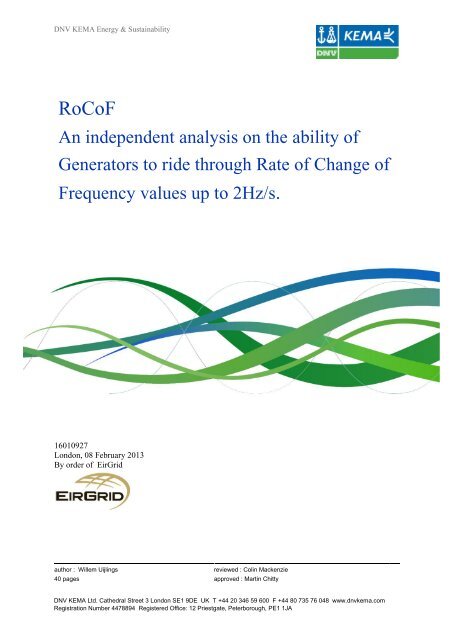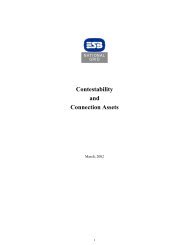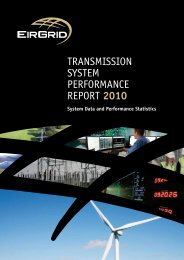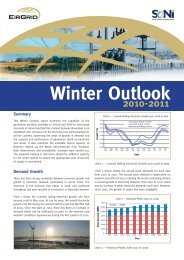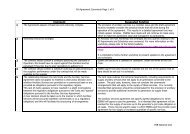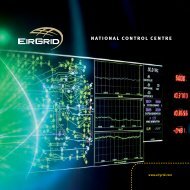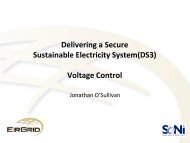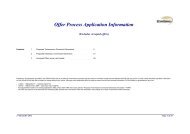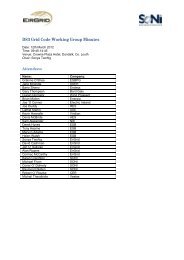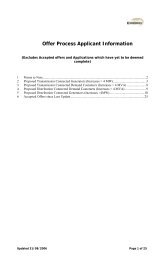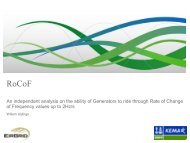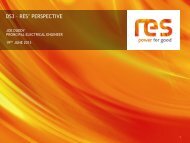DNV KEMA RoCoF Report - Eirgrid
DNV KEMA RoCoF Report - Eirgrid
DNV KEMA RoCoF Report - Eirgrid
Create successful ePaper yourself
Turn your PDF publications into a flip-book with our unique Google optimized e-Paper software.
<strong>DNV</strong> <strong>KEMA</strong> Energy & Sustainability<br />
<strong>RoCoF</strong><br />
An independent analysis on the ability of<br />
Generators to ride through Rate of Change of<br />
Frequency values up to 2Hz/s.<br />
16010927<br />
London, 08 February 2013<br />
By order of EirGrid<br />
author : Willem Uijlings<br />
reviewed : Colin Mackenzie<br />
40 pages approved : Martin Chitty<br />
<strong>DNV</strong> <strong>KEMA</strong> Ltd. Cathedral Street 3 London SE1 9DE UK T +44 20 346 59 600 F +44 80 735 76 048 www.dnvkema.com<br />
Registration Number 4478894 Registered Office: 12 Priestgate, Peterborough, PE1 1JA
© <strong>DNV</strong> <strong>KEMA</strong> Limited. All rights reserved.<br />
This document contains confidential information that shall not be transmitted to any third party without written consent of <strong>DNV</strong><br />
<strong>KEMA</strong> Limited. The same applies to file copying (including but not limited to electronic copies), wholly or partially. It is prohibited<br />
to change any and all versions of this document in any manner whatsoever, including but not limited to dividing it into parts. In<br />
case of a conflict between an electronic version (e.g. PDF file) and the original paper version provided by <strong>DNV</strong> <strong>KEMA</strong>, the latter<br />
will prevail.<br />
<strong>DNV</strong> <strong>KEMA</strong> Limited and/or its associated companies disclaim liability for any direct, indirect, consequential or incidental<br />
damages that may result from the use of the information or data, or from the inability to use the information or data contained in<br />
this document.
<strong>DNV</strong> <strong>KEMA</strong> Energy & Sustainability<br />
CONTENTS<br />
PAGE<br />
1 Executive Summary ............................................................................................................. 5<br />
2 Introduction .......................................................................................................................... 8<br />
3 Project Approach and Methodology .................................................................................. 10<br />
4 Results ................................................................................................................................ 11<br />
4.1 Instability ........................................................................................................................... 13<br />
4.2 Reverse power.................................................................................................................... 15<br />
4.3 Stable operation ................................................................................................................. 17<br />
4.4 Stress on the Synchronous Machine .................................................................................. 18<br />
5 Conclusion ......................................................................................................................... 20<br />
6 Appendix ............................................................................................................................ 22<br />
6.1 Results ................................................................................................................................ 22<br />
6.1.1 Results 0.5, 1 and 2 Hz/s over a rolling window of 500 ms .............................................. 23<br />
6.1.2 Results 0.5, 1 and 2 Hz/s with a total frequency drop of 1 Hz .......................................... 29<br />
6.1.3 Results 0.5, 1 and 1.5 Hz/s with a total frequency drop of 1 Hz ....................................... 35<br />
16010927 -3-
<strong>DNV</strong> <strong>KEMA</strong> Energy & Sustainability<br />
1 EXECUTIVE SUMMARY<br />
EirGrid asked <strong>DNV</strong> <strong>KEMA</strong> to perform a study on behalf of the Transmission System<br />
Operators (TSOs), EirGrid and SONI, in Ireland and Northern Ireland to identify limitations for<br />
the current energy providers to meet Rate of Change of Frequency (<strong>RoCoF</strong>) values of up to<br />
2 Hz/s. <strong>RoCoF</strong> values introduced and analysed in this study are 0.5, 1, 1.5 and 2 Hz/s.<br />
The analyses show that a <strong>RoCoF</strong> of up to a 1 Hz/s for all generators analysed in this report<br />
could achieve compliance, apart from a leading power factor. Though there are signs of<br />
instability for 1.5 Hz/s and 2 Hz/s. In general the study shows that a 2 Hz/s <strong>RoCoF</strong> value is<br />
not achievable with the current generation sets, apart from the small OCGT and the salientpole<br />
Hydro machine as exceptions. 1.5 Hz/s can only be achieved by some generators and<br />
not for a leading power factor. 1 Hz/s shows theoretical compliance, looking at a 500 ms<br />
rolling window, though not for leading power factor. Were a <strong>RoCoF</strong> value of 1 Hz/s required<br />
to be tolerated by the generators, to avoid instability or adverse effects on the generator or its<br />
operational performance good advice would be to restrict operational modes (i.e. leading<br />
power factor operation) for generators that may be at risk.<br />
In terms of mechanical stress, torque values of the machines do increase with the higher<br />
<strong>RoCoF</strong> values. Calculations show a maximum torque around 140 % of the nominal rated<br />
value of the machine for a 0.5 Hz/s <strong>RoCoF</strong>. The maximum torque for a <strong>RoCoF</strong> of 1 Hz/s is<br />
around 160 %. Generators in general are capable of handling (to some extent) short circuits<br />
where torque values may typically vary from 400 % to 600 % of the nominal value.<br />
Considering those aspects, the torque associated with the investigated <strong>RoCoF</strong> values do not<br />
introduce an immediate 1 risk to the generator. For example the Ireland grid code specifies<br />
fault ride-through criteria regarding voltage dip magnitude. The present generators in Ireland<br />
have to be compliant with these requirements. This compliance could result in mechanical<br />
stress values of approx. 300 % to 400 % of the nominal rated value, above those estimated<br />
for the higher <strong>RoCoF</strong> values investigated.<br />
The two tables on the next page show the results from the theoretical model used in this<br />
study to identify the stability of the synchronous machines. The first table present the<br />
analyses results for a rolling 500 ms window. Because a fixed rolling time window results in<br />
different absolute frequency drops for differed <strong>RoCoF</strong> values, additional calculations were<br />
preformed for a total frequency drop of 1 Hz. A summary of these results is given in the<br />
second table.<br />
1 It is possible that the wear and tear of the machine might be affected to some extent. In addition, investigation<br />
is needed to the eigenvalue of the machine and the frequency of the torque swing induced.<br />
16010927 -5-
<strong>DNV</strong> <strong>KEMA</strong> Energy & Sustainability<br />
A summary of the analyses results in Ireland and Northern Ireland for the investigated<br />
<strong>RoCoF</strong> values based on a rolling 500ms time window are given below.<br />
Generation Units Result Summary<br />
500 ms window<br />
Generator Set<br />
Unit<br />
Size<br />
Inertia<br />
Constant H<br />
[name] [MW] [Sec.] [p.u.] [kV]<br />
Xd<br />
Terminal<br />
Voltage Stable during <strong>RoCoF</strong><br />
[@ 0.5 [@ 1.0 [@ 2.0<br />
Hz/s] Hz/s] Hz/s]<br />
CCGT Single-shaft 400 5.5 1.9 20 Y Y* N<br />
CCGT Dual-Shaft 260 6 2.3 17 Y Y* N<br />
CCGT Dual-Shaft 140 9 2.1 17 Y Y* N<br />
Steam Thermal (Reheat) 300 5 1.7 17 Y Y* N**<br />
Steam Thermal (Once<br />
Through) 250 4.5 2.3 20 Y Y* N<br />
Steam Thermal (Fluidized<br />
bed peat) 150 8 2.2 11 Y Y* N<br />
OCGT 50 1.5 2.9 11 Y Y* Y*<br />
Salient-pole Hydro 30 2.7 1.4 11 Y Y Y<br />
A summary of the analyses results in Ireland and Northern Ireland for the investigated<br />
<strong>RoCoF</strong> values based on a total frequency drop of 1Hz are given below.<br />
Generation Units Result Summary<br />
1 Hz total frequency drop<br />
Generator Set<br />
Unit<br />
Size<br />
Inertia<br />
Constant H<br />
Xd<br />
Terminal<br />
Voltage<br />
[name] [MW] [Sec.] [p.u.] [kV]<br />
Stable during <strong>RoCoF</strong><br />
[@ 0.5 [@ 1.0 [@ 1.5<br />
Hz/s] Hz/s] Hz/s]<br />
[@<br />
2.0Hz/s]<br />
CCGT Single-shaft 400 5.5 1.9 20 Y Y* Y* N<br />
CCGT Dual-Shaft 260 6 2.3 17 Y N N N<br />
CCGT Dual-Shaft 140 9 2.1 17 Y N N N<br />
Steam Thermal (Reheat) 300 5 1.7 17 Y Y* Y* N**<br />
Steam Thermal (Once<br />
Through) 250 4.5 2.3 20 Y* Y* N N<br />
Steam Thermal<br />
(Fluidized bed peat) 150 8 2.2 11 Y* N N N<br />
OCGT 50 1.5 2.9 11 Y* Y* Y* Y*<br />
Salient-pole Hydro 30 2.7 1.4 11 Y Y Y Y<br />
The tables give a general overview of the findings where:<br />
Y is used to indicate stable operation<br />
Y* is used where a pole slip is only observed for a 0.93 leading power factor operation mode;<br />
N is used when a pole slip is also observed for power factors of 1 unity or/and 0.85 lag;<br />
N** is used when no pole slip is observed for power factors of 1 unity or/and 0.85 lag but negative power generation is detected.<br />
-6- 16010927
<strong>DNV</strong> <strong>KEMA</strong> Energy & Sustainability<br />
The calculations for this study are performed using numerical analysis in a semi simplified<br />
mathematical model of a synchronous machine. The chosen generator characteristics used<br />
in the model were provided by the TSOs, capturing a large part of the typical asset<br />
parameters found in Ireland and Northern Ireland. In the model, the synchronous machine is<br />
attached to an infinite bus. First the <strong>RoCoF</strong> was used to initiate a linear frequency drop of the<br />
bus over a 500 ms period. To be able to observe the effect of an equal absolute frequency<br />
drop of 1 Hz for different <strong>RoCoF</strong> values, additional analyses were preformed<br />
Results presented in this document are not an exact outcome but are a first reasonable<br />
estimate to give guidance of the main implications for the provision of higher <strong>RoCoF</strong> values<br />
proposed by EirGrid and SONI.<br />
16010927 -7-
<strong>DNV</strong> <strong>KEMA</strong> Energy & Sustainability<br />
2 INTRODUCTION<br />
The Government targets for Ireland and the ambition for Northern Ireland (NI) are to have<br />
40.% renewable energy penetration by 2020. EirGrid and SONI have put in place a multiyear,<br />
multi-stakeholder programme of work, “Delivering a Secure Sustainable System”<br />
(DS3), to enable efficient, reliable and secure power system operation. Through the DS3<br />
system services review, the challenges to ensure sufficient and appropriate system services<br />
have been identified. In detailed studies and technical analysis the TSOs established the<br />
need for additional system services, and also proposed new products to address the<br />
emerging challenges associated with achieving the governments’ renewable energy policy<br />
objectives and ambitions.<br />
Renewable energy has an impact on the inertia of the electrical network which in turn<br />
impacts the potential rate of change of frequency to network events such as short circuits,<br />
large step load changes and loss of generation. EirGrid and SONI estimated that having<br />
40.% of renewable energy by 2020 will have a significant impact on the Rate of Change of<br />
Frequency (<strong>RoCoF</strong>) experienced in the network.<br />
EirGrid has asked <strong>DNV</strong> <strong>KEMA</strong>, in this context, to identify what the impact for the current<br />
generators would be if the present <strong>RoCoF</strong> capability requirement were to be changed from<br />
0.5 Hz/s to 1 Hz/s, to 1.5 Hz/s, or to 2 Hz/s.<br />
This report gives a general view of the impact on energy generating assets in Ireland and<br />
Northern Ireland of increased <strong>RoCoF</strong> values. It shows in which situations generators will<br />
become unstable during a higher <strong>RoCoF</strong> value as opposed to the present limit stated in the<br />
grid code.<br />
<strong>RoCoF</strong> protection was introduced for anti-islanding for embedded generation. The protection<br />
aims to detect severe issues in the electricity grid. The speed of change of the frequency is<br />
used for the event of serious issues in the electrical network and to disconnect the generator<br />
from the grid in such an event. Anti-islanding prevents small generators being left to supply<br />
local loads with the additional loss of correct reference for the protection equipment. Small<br />
generators (
<strong>DNV</strong> <strong>KEMA</strong> Energy & Sustainability<br />
The speed of frequency changes at high renewable penetration show higher <strong>RoCoF</strong> values<br />
than presently anticipated for, hence, energy generation units could be disconnected from<br />
the grid resulting in a brown out or black out if other measures are not taken, and, in a worst<br />
case, the assets could be damaged in the event of a pole slip. Making sure that the assets<br />
can cope with the faster allowance of frequency rise or drop, together with changing the<br />
<strong>RoCoF</strong>/vector shift protection settings, is therefore one way of improving the Network<br />
stability.<br />
Results presented in this document are not an exact outcome but are a first reasonable<br />
estimate of the main implications for the provision of higher <strong>RoCoF</strong> values proposed by<br />
EirGrid and SONI. Without detailed investigations on each specific generation asset it is not<br />
possible to make a final statement on the compliance of each asset. However, <strong>DNV</strong> <strong>KEMA</strong><br />
believes that this report gives clear and useful insight of the implications for the generators<br />
examined here of the increased <strong>RoCoF</strong> values studied.<br />
16010927 -9-
<strong>DNV</strong> <strong>KEMA</strong> Energy & Sustainability<br />
3 PROJECT APPROACH AND METHODOLOGY<br />
<strong>DNV</strong> <strong>KEMA</strong> used their extensive knowledge and expertise to produce a method to identify<br />
limitations for the current energy providers regarding the higher <strong>RoCoF</strong> values proposed for<br />
Ireland and Northern Ireland not looking at the protection devices themselves. The project<br />
focus was targeted around synchronous generators and their capability. To be able to<br />
explain the behaviour of synchronous generators for different <strong>RoCoF</strong> values, proof was<br />
needed in the form of calculations. <strong>DNV</strong> <strong>KEMA</strong> designed a semi simplified mathematical<br />
calculation model of a synchronous machine using a numerical analysis. With this model the<br />
effects on generators can be calculated when changing the <strong>RoCoF</strong> value.<br />
In the model the machine is attached to an infinite bus. The frequency deviation is initiated<br />
using the different <strong>RoCoF</strong> values creating a linear frequency drop. It was ensured that<br />
independent of the <strong>RoCoF</strong> value, the total drop in frequency was 1 Hz. This means that for a<br />
0.5 Hz/s <strong>RoCoF</strong> the duration of the frequency drop is 2 seconds as opposed to a 2 Hz/s<br />
<strong>RoCoF</strong> where the duration is 0.5 seconds to reach a 1 Hz drop. The total frequency drop is<br />
based on the system boundaries for normal operation. Load shedding in Ireland and<br />
Northern Ireland starts at 48.85 Hz. Therefore the TSO will aim to keep the frequency at least<br />
above 49 Hz for a loss of the largest in feed.<br />
<strong>DNV</strong> <strong>KEMA</strong> also investigated the effects of <strong>RoCoF</strong> values during a shorter timeframe and<br />
results are presented for a 500 ms window in the appendix to this report. In addition a short<br />
comparison was carried out for higher <strong>RoCoF</strong> values combined with a shorter timeframe<br />
keeping within a 1 Hz drop. Although out of scope for this study, some inside information on<br />
these additional investigations is provided in the conclusions to this report.<br />
Our approach may paint a more pessimistic picture than found in reality as the model used<br />
does not include speed governor action or system damping effects. A full PSSE model could<br />
be more accurate, for example, and if designed correctly, able to capture the instability<br />
phenomena should they have the potential to occur. The numerical analysis used here,<br />
though, reveals a clear picture of the ability of generators with the given parameters in this<br />
report to ride-through the higher <strong>RoCoF</strong> values proposed. That said, it should be noted that<br />
the <strong>RoCoF</strong> investigated here is more related to mechanical phenomena as opposed to<br />
electrical dynamic effects. The mechanical phenomena occurs much slower in time as<br />
opposed to the electrical phenomena. As an important result, the electrical dynamic effects<br />
will have already happened in time before the frequency starts dropping. This means that the<br />
numerical analysis used in this report is appropriate for analysing <strong>RoCoF</strong> implications.<br />
Having designed the generic model, representative generator sets for Ireland and Northern<br />
Ireland were identified together with the possible operating and technical values required for<br />
-10- 16010927
<strong>DNV</strong> <strong>KEMA</strong> Energy & Sustainability<br />
the model input. Representative generator model details were checked, altered and<br />
confirmed by EirGrid and SONI. A summary of the agreed generator details is given here.<br />
Generation Units<br />
Generator Set<br />
Unit<br />
Size<br />
Inertia Constant<br />
H<br />
Terminal<br />
Voltage<br />
[name] [MW] [Sec.] [kV] [p.u.]<br />
CCGT Single-shaft 400 5.5 20 1.9<br />
CCGT Dual-Shaft 260 6 17 2.3<br />
CCGT Dual-Shaft 140 9 17 2.1<br />
Steam Thermal (Reheat) 300 5 17 1.7<br />
Steam Thermal (Once Through) 250 4.5 20 2.3<br />
Steam Thermal (Fluidized bed peat) 150 8 11 2.2<br />
OCGT 50 1.5 11 2.9<br />
Salient-pole Hydro 30 2.7 11 1.4<br />
Xd<br />
The representative generator list was then used for stability calculations, power swing and<br />
accompanied mechanical stress values.<br />
Operational parameters introduced within the mathematical model to simulate the behaviour<br />
of each generator set are:<br />
- Power factors: 0.85 lag, 1 unity, 0.93 lead<br />
- Load factors: 80 %, 100 %.<br />
In the approach looking at the protection devices themselves and their implications are left<br />
out of scope.<br />
4 RESULTS<br />
This chapter provides the typical outcomes of the studies carried out. The complete overview<br />
can be found in the appendix to this report. The total results for each individual set of<br />
operational parameters for each individual generation set are listed there. This chapter gives<br />
a description and explanation of the typical findings throughout the analyses.<br />
Together with the operational parameters, the following <strong>RoCoF</strong> values are introduced within<br />
the mathematical model to simulate the behaviour of each generator, namely:<br />
- <strong>RoCoF</strong>: -0.5 Hz/s, -1 Hz/s, -1.5 Hz/s and -2 Hz/s.<br />
16010927 -11-
<strong>DNV</strong> <strong>KEMA</strong> Energy & Sustainability<br />
The calculations show that changing the <strong>RoCoF</strong> setting has a large impact on the<br />
synchronous machine. Also it showed that there is not one specific parameter that solely<br />
determines the capability of the machine. Inertia, number of poles, power factor (cos φ) and<br />
load all have an influence on the <strong>RoCoF</strong> capability. Inertia and poles are fixed parameters<br />
characteristics of the machine as opposed to the power factor and load, which can be<br />
controlled by the excitation and the governor.<br />
As an example looking at a full 1 Hz drop the CCGT dual shaft generators show -capability<br />
issues of handling a 1 Hz/s <strong>RoCoF</strong> value. Though the single shaft CCGT is capable of<br />
coping with the 1 Hz/s <strong>RoCoF</strong>. Analysing these outcomes identifies that the single shaft<br />
CCGT has the capability because of the lower inertia or/and synchronous reactance value. If<br />
one of those values in the Dual shaft machines is altered the capability changes.<br />
In general, increasing <strong>RoCoF</strong> values show the following effects:<br />
- Torque swings<br />
- Pole slip<br />
- Momentary reverse power.<br />
<strong>DNV</strong> <strong>KEMA</strong> calculated the technical capability of the agreed synchronous generator<br />
characteristics to various <strong>RoCoF</strong> values. The results are summarised below.<br />
Generation Units Result Summary<br />
Generator Set<br />
Unit<br />
Size<br />
Inertia<br />
Constant H<br />
Xd<br />
Terminal<br />
Voltage<br />
[name] [MW] [Sec.] [p.u.] [kV]<br />
1 Hz total frequency drop<br />
Stable during <strong>RoCoF</strong><br />
[@ 0.5 [@ 1.0 [@ 1.5<br />
Hz/s] Hz/s] Hz/s]<br />
[@<br />
2.0Hz/s]<br />
CCGT Single-shaft 400 5.5 1.9 20 Y Y* Y* N<br />
CCGT Dual-Shaft 260 6 2.3 17 Y N N N<br />
CCGT Dual-Shaft 140 9 2.1 17 Y N N N<br />
Steam Thermal (Reheat) 300 5 1.7 17 Y Y* Y* N**<br />
Steam Thermal (Once<br />
Through) 250 4.5 2.3 20 Y* Y* N N<br />
Steam Thermal<br />
(Fluidized bed peat) 150 8 2.2 11 Y* N N N<br />
OCGT 50 1.5 2.9 11 Y* Y* Y* Y*<br />
Salient-pole Hydro 30 2.7 1.4 11 Y Y Y Y<br />
The table gives a general overview of the findings where:<br />
Y is used for stable operation;<br />
Y* is used where a pole slip is only observed for a 0.93 leading power factor operation mode;<br />
N is used when a pole slip is also observed for power factors of 1 unity or/and 0.85 lag;<br />
N** is used when no pole slip is observed for power factors of 1 unity or/and 0.85 lag but negative power generation is detected.<br />
Detailed results for every value can be found in the appendix to this report.<br />
-12- 16010927
<strong>DNV</strong> <strong>KEMA</strong> Energy & Sustainability<br />
4.1 Instability<br />
When the machine is unable to follow the fast reduction in speed, the rotor loses its opposed<br />
force from the electricity grid and will therefore speed up. The fast change of the stator field<br />
frequency results here in an inadequate rotor reaction. In other words, the rotor is not able to<br />
follow the speed change of the stator field frequency. This reflects back to the amount of<br />
attractive force between both stator and rotor fields combined with inertia of the machine.<br />
The attractive force between both fields can be controlled by changing the power factor<br />
or/and the load of the machine. This explains why different operating parameters could make<br />
the unit capable or not capable of tolerating a certain <strong>RoCoF</strong> value.<br />
In the event that the combination of the attractive force and the inertia is not efficient to keep<br />
the rotor field in control, the machine will pole slip. This will most likely severely damage the<br />
machine. Our developed model shows the following typical outcome at the event of a pole<br />
slip.<br />
400.00<br />
250 MW CCGT dual shaft<br />
390.00<br />
<strong>RoCoF</strong>: -1 Hz/s<br />
380.00<br />
Power factor: 1<br />
370.00<br />
Load: 100 %<br />
Poles: 2<br />
360.00<br />
350.00<br />
340.00<br />
330.00<br />
320.00<br />
310.00<br />
300.00<br />
0.000 2.000 4.000 6.000 8.000 10.000<br />
wm<br />
wfield<br />
The figure above is for a 2 pole machine. It can be observed that the Stator field (red line)<br />
comes down starting at 314 rad/s. The blue line (rotor field) tries to follow but the machine<br />
loses it synchronism. This results in a pole slip and the magnetic force of the stator is not<br />
able to attract the rotor field anymore. Since power is still applied to the rotor the machine will<br />
speed up as there is no opposing force anymore. At that moment the over speed protection<br />
will engage but damage may already be done.<br />
16010927 -13-
<strong>DNV</strong> <strong>KEMA</strong> Energy & Sustainability<br />
1500.00<br />
1000.00<br />
250 MW 3.000 CCGT dual shaft<br />
<strong>RoCoF</strong>: -1 Hz/s<br />
Power factor: 1<br />
Load: 2.500 100 %<br />
Poles: 2<br />
500.00<br />
2.000<br />
0.00<br />
1.500<br />
0.000 0.500 1.000 1.500 2.000 2.500 3.000 3.500<br />
power<br />
torque<br />
pole angle<br />
-500.00<br />
1.000<br />
-1000.00<br />
0.500<br />
-1500.00<br />
0.000<br />
The graph above shows the torque, power and pole angle. The pole angle is between the<br />
stator field and the rotor field. The machine will lose its synchronism if the angle becomes<br />
greater than 90 degrees or ½π rad. This graph enables observation of the stability in more<br />
detail. Looking at the pole angle (purple line) synchronism is lost after approx. 520 ms. The<br />
torque shows at that period a peak and then drops significantly. The generator output power<br />
curve (blue line) also drops and is oscillating under and above the zero line. The latter<br />
indicates that the synchronous machine on average does not produce power anymore,<br />
hence the rotor is not able to induce its power into the stator. Instead the power is used to<br />
speeds up the rotor.<br />
-14- 16010927
<strong>DNV</strong> <strong>KEMA</strong> Energy & Sustainability<br />
4.2 Reverse power<br />
At the event of generating reverse power the machine does not necessarily pole slip but<br />
generates for short moments in time negative power. In other words it consumes power in<br />
short periods of time. When a generator is consuming active power it operates like a motor.<br />
The next graph shows that the rotor keeps in check 2 with the reduced stator (electrical) field<br />
frequency.<br />
400.00<br />
250 MW CCGT dual shaft<br />
390.00<br />
<strong>RoCoF</strong>: -1.5 Hz/s<br />
380.00<br />
Power factor: 0.85 lag<br />
Load: 80 %<br />
370.00<br />
Poles: 2<br />
360.00<br />
350.00<br />
340.00<br />
wm<br />
wfield<br />
330.00<br />
320.00<br />
310.00<br />
300.00<br />
0.000 2.000 4.000 6.000 8.000 10.000<br />
At the same time the synchronous machine is acting as a motor in short periods of time,<br />
shown in the following graph.<br />
2 Because the model is simplified, there is no damping in the oscillation around the electrical field<br />
speed. In reality this will flatten-out to a constant value.<br />
16010927 -15-
<strong>DNV</strong> <strong>KEMA</strong> Energy & Sustainability<br />
1400.00<br />
1200.00<br />
1000.00<br />
250 MW 3.000 CCGT dual shaft<br />
<strong>RoCoF</strong>: -1.5 Hz/s<br />
Power factor: 0.85 lag<br />
Load: 2.500 80 %<br />
Poles: 2<br />
800.00<br />
600.00<br />
400.00<br />
200.00<br />
2.000<br />
1.500<br />
1.000<br />
power<br />
torque<br />
pole angle<br />
0.00<br />
0.500<br />
0.000 0.500 1.000 1.500 2.000 2.500 3.000 3.500<br />
-200.00<br />
0.000<br />
Following the frequency change the accompanied torque swings, due to the inertia and<br />
current field behaviour, could be such that the power output of the generator can be<br />
momentarily reversed (blue line). The generator is protected against Motor operation by the<br />
reverse power protection. If triggered it will shutdown the unit. The directional active<br />
overpower protection is triggered depending on the net amount of power generation. A<br />
normal (32P) setting on the protection relays is a threshold of 5 % of nominal apparent power<br />
(Sn) with a delay of a few seconds. To know if a certain unit will stay connected when<br />
reverse power is observed, a detailed bespoke simulation is necessary including all machine<br />
and protections specifics. On the graph shown here (above) it is unlikely that the directional<br />
active overpower protection will disconnect the unit from the grid.<br />
-16- 16010927
<strong>DNV</strong> <strong>KEMA</strong> Energy & Sustainability<br />
4.3 Stable operation<br />
When the machine shows stable operation, our model typically gives the following graphs.<br />
400.00<br />
250 MW CCGT dual shaft<br />
390.00<br />
<strong>RoCoF</strong>: -1.0 Hz/s<br />
380.00<br />
Power factor: 0.85 lag<br />
370.00<br />
Load: 100 %<br />
360.00<br />
Poles: 2<br />
350.00<br />
340.00<br />
wm<br />
wfield<br />
330.00<br />
320.00<br />
310.00<br />
300.00<br />
0.000 2.000 4.000 6.000 8.000 10.000<br />
The above graph displays the stator frequency drop in rad/s (red line). The rotor field (blue<br />
line) wants at first to stay at the same speed and after approx. 300 ms the stator frequency is<br />
followed. The rotor frequency keeps dropping a bit while the stator frequency is stabilized.<br />
Soon after though, the rotor frequency speeds up a little and keeps following the new stator<br />
frequency 3 .<br />
3 In the graph a little ripple is shown up till 10 seconds with the same amplitude. This is because of the<br />
model used as no damping. In reality this will flatten-out to a constant value.<br />
16010927 -17-
<strong>DNV</strong> <strong>KEMA</strong> Energy & Sustainability<br />
1400.00<br />
1200.00<br />
1000.00<br />
800.00<br />
600.00<br />
400.00<br />
200.00<br />
250 MW 3.000 CCGT dual shaft<br />
<strong>RoCoF</strong>: -1.0 Hz/s<br />
Power factor: 0.85 lag<br />
Load: 2.500 100 %<br />
Poles: 2<br />
2.000<br />
power<br />
1.500<br />
torque<br />
pole angle<br />
1.000<br />
0.500<br />
0.00<br />
0.000 0.500 1.000 1.500 2.000 2.500 3.000 3.500<br />
0.000<br />
In the graph above the torque, power and pole angle are illustrated. The pole angle stays<br />
well within 90 degrees or ½π rad. Now the torque can be observed showing no negative<br />
value. Note that this results in a constant positive power flow through time and not as<br />
illustrated, this is a result of the semi simplified model used.<br />
4.4 Stress on the Synchronous Machine<br />
The torque in all example graphs of chapter 4.1, 4.2 and 4.3 show an increase. The initial<br />
torque value, at t = 0 s, is the stable value (not necessary the nominal value of the machine)<br />
when no change is made in frequency, load or power factor. As soon the frequency is<br />
dropped the angle between the electrical stator field and rotor increases resulting in a greater<br />
force between the two magnetic fields, hence more power is momentarily demanded from<br />
the machine. The higher the <strong>RoCoF</strong>, under the same load conditions, the higher the torque<br />
increase. Observe the difference in the graph of chapter 4.3 where the torque is displayed for<br />
a 1.0 Hz/s <strong>RoCoF</strong> and the graph in this chapter showing the torque for a -0.5 Hz/s <strong>RoCoF</strong>.<br />
The generator inertia causes a time delay. This time delay results in a torque swing<br />
accompanied by a decrease and increase in rotor speed against the Stator field. It is<br />
important to look at the frequency of the torque swing. If this frequency comes close to the<br />
eigenvalue of the machine the machine could become unstable due to resonance<br />
frequencies.<br />
-18- 16010927
<strong>DNV</strong> <strong>KEMA</strong> Energy & Sustainability<br />
1200.00<br />
1000.00<br />
800.00<br />
250 MW 3.000 CCGT dual shaft<br />
<strong>RoCoF</strong>: -0.5 Hz/s<br />
Power factor: 0.85 lag<br />
Load: 2.500 100 %<br />
Poles: 2<br />
2.000<br />
600.00<br />
400.00<br />
1.500<br />
1.000<br />
power<br />
torque<br />
pole angle<br />
200.00<br />
0.500<br />
0.00<br />
0.000 0.500 1.000 1.500 2.000 2.500 3.000 3.500 4.000<br />
0.000<br />
The -0.5 Hz/s <strong>RoCoF</strong> shows a maximum of 128 % of the nominal torque value of this<br />
synchronous machine as opposed to a 153 % value with -1.0 Hz/s <strong>RoCoF</strong>. Considering the<br />
current Fault Ride-Through requirements in Ireland and Northern Ireland these torque values<br />
due to <strong>RoCoF</strong> are closer to normal operational torque values than torques experienced<br />
under short circuit conditions.<br />
Generators remaining synchronised during a fault disturbance which is causing a voltage dip<br />
of 95 % (5 % retained) at the HV terminals of the generator transformer delivers significantly<br />
more stress. Calculations show that an increase of 300 to 500 % of the nominal torque value<br />
of the machine could occur.<br />
Therefore the increase of 153 % in torque of the nominal value will not cause immediate<br />
failure of the synchronous machines currently compliant with the Ireland and Northern Ireland<br />
grid code. Considerations however may need to be made regarding lifetime reduction/<br />
maintenance intervals. Allowing multiple <strong>RoCoF</strong> events each year could effect lifetime.<br />
Lifetime assessment with regards to allowable <strong>RoCoF</strong> events are outside the scope of this<br />
project.<br />
16010927 -19-
<strong>DNV</strong> <strong>KEMA</strong> Energy & Sustainability<br />
5 CONCLUSION<br />
The analyses results can be found in the appendix. For the 500 ms rolling time window no<br />
unstable operation is found at a <strong>RoCoF</strong> of 1 Hz/s, apart from a leading power factor<br />
operating condition. As a result it seems likely that all generators analysed in this document<br />
should be capable of tolerating such an event without obvious negative effects.<br />
During the study it became clear that this becomes different for a longer time window looking<br />
at a 1 Hz frequency drop and the higher <strong>RoCoF</strong> values of 1.5 Hz/s and 2 Hz/s where<br />
unstable operation was detected.<br />
In terms of mechanical stress during stable operation, no values that could lead to immediate<br />
catastrophic failure were found as result of increased <strong>RoCoF</strong> values. Therefore <strong>DNV</strong> <strong>KEMA</strong><br />
concludes that when a machine is healthy and shows stable operation, the proposed <strong>RoCoF</strong><br />
values do not pose an immediate threat. Other requirements other than <strong>RoCoF</strong> in the grid<br />
code can pose greater burdens on the synchronous machines. Though without detailed<br />
investigations on each specific generation asset it is not possible to make a final statement<br />
on the higher <strong>RoCoF</strong> compliance.<br />
To estimate the stability implications <strong>DNV</strong> <strong>KEMA</strong> employed a numerical analysis using a<br />
semi simplified mathematical model of a synchronous machine. This approach may paint a<br />
more pessimistic picture since it does not include any network damping contributions that<br />
occur in reality.<br />
Notwithstanding this, the calculation results determined that the forces during high <strong>RoCoF</strong><br />
would exceed the maximum steady state torque experienced. The highest value found for a<br />
1 Hz/s <strong>RoCoF</strong> was 176 %. On average the torque values for a 1 Hz/s <strong>RoCoF</strong> are around 160<br />
%. However this is considerably less than the estimated 300.% to 400 % torque experienced<br />
for voltage dips due to network short circuits on generators as mandated in the Ireland Grid<br />
Code and supported by existing experiences to date. To properly estimate the forces during<br />
higher <strong>RoCoF</strong> events detailed analysis maybe required. Though given the stated capability of<br />
existing generators to ride through undamaged forces of 300 % to 400 %, immediate failure<br />
is not to be expected. However, further investigation is needed to analyse the effect on wear<br />
and tear and the accompanied maintenance schedules that may need adjusting due to an<br />
increased frequency of higher <strong>RoCoF</strong> events.<br />
It is important to note that when the duration of the <strong>RoCoF</strong> event is shortened, higher <strong>RoCoF</strong><br />
values could be possible. For example, the 260 MW CCGT Dual-shaft machine remains<br />
stable for a 250ms <strong>RoCoF</strong> event of -2.2 Hz/s under the operation conditions of 100 % load<br />
and a power factor of 1 unity.<br />
-20- 16010927
<strong>DNV</strong> <strong>KEMA</strong> Energy & Sustainability<br />
The use of a fully developed dynamic simulation (e.g. PSSE or DigSilent applications) should<br />
be more accurate and if designed correctly able to more appropriately predict and estimate<br />
the instability phenomena including the damping implications. Within the scope of this project<br />
such an exercise was not feasible. However the simplified model used identified a clear<br />
general picture of where a generator is likely to become unstable.<br />
Further investigation is required to allow for appropriate protection settings and devices when<br />
higher <strong>RoCoF</strong> values are accepted in the electricity grid, since this is not a straight-forward<br />
matter.<br />
16010927 -21-
<strong>DNV</strong> <strong>KEMA</strong> Energy & Sustainability<br />
6 APPENDIX<br />
6.1 Results<br />
Summary results for the 0.5, 1 and 2 Hz/s <strong>RoCoF</strong> over a rolling window of 500 ms<br />
Generation Units Result Summary<br />
Generator Set<br />
Unit<br />
Size<br />
Inertia<br />
Constant H<br />
[name] [MW] [Sec.] [p.u.] [kV]<br />
Xd<br />
500 ms window<br />
Terminal<br />
Voltage Stable during <strong>RoCoF</strong><br />
[@ .5 [@ 1 [@ 2<br />
Hz/s] Hz/s] Hz/s]<br />
CCGT Single-shaft 400 5.5 1.9 20 Y Y* N<br />
CCGT Dual-Shaft 260 6 2.3 17 Y Y* N<br />
CCGT Dual-Shaft 140 9 2.1 17 Y Y* N<br />
Steam Thermal (Reheat) 300 5 1.7 17 Y Y* N**<br />
Steam Thermal (Once<br />
Through) 250 4.5 2.3 20 Y Y* N<br />
Steam Thermal (Fluidized<br />
bed peat) 150 8 2.2 11 Y Y* N<br />
OCGT 50 1.5 2.9 11 Y Y* Y*<br />
Salient-pole Hydro 30 2.7 1.4 11 Y Y Y<br />
Summary results for the 0.5, 1, 1.5 and 2 Hz/s <strong>RoCoF</strong> for a total of 1 Hz frequency drop<br />
Generation Units Result Summary<br />
Generator Set<br />
Unit<br />
Size<br />
Inertia<br />
Constant<br />
H<br />
[name] [MW] [Sec.] [p.u.] [kV]<br />
Xd<br />
1 Hz total frequency drop<br />
Terminal<br />
Voltage Stable during <strong>RoCoF</strong><br />
[@ .5 [@ 1 [@ 1.5 [@ 2<br />
Hz/s] Hz/s] Hz/s] Hz/s]<br />
CCGT Single-shaft 400 5.5 1.9 20 Y Y* Y* N<br />
CCGT Dual-Shaft 260 6 2.3 17 Y N N N<br />
CCGT Dual-Shaft 140 9 2.1 17 Y N N N<br />
Steam Thermal (Reheat) 300 5 1.7 17 Y Y* Y* N**<br />
Steam Thermal (Once<br />
Through) 250 4.5 2.3 20 Y* Y* N N<br />
Steam Thermal (Fluidized<br />
bed peat) 150 8 2.2 11 Y* N N N<br />
OCGT 50 1.5 2.9 11 Y* Y* Y* Y*<br />
Salient-pole Hydro 30 2.7 1.4 11 Y Y Y Y<br />
The tables give a general overview of the findings where:<br />
Y is used to indicate stable operation<br />
Y* is used where a pole slip is only observed for a 0.93 leading power factor operation mode;<br />
N is used when a pole slip is also observed for power factors of 1 unity or/and 0.85 lag;<br />
N** is used when no pole slip is observed for power factors of 1 unity or/and 0.85 lag but negative power generation is detected.<br />
-22- 16010927
<strong>DNV</strong> <strong>KEMA</strong> Energy & Sustainability<br />
6.1.1 Results 0.5, 1 and 2 Hz/s over a rolling window of 500 ms<br />
Generation Units Result Summary<br />
500 ms window<br />
Generator Set<br />
Unit<br />
Size<br />
Inertia<br />
Constant H<br />
[name] [MW] [Sec.] [p.u.] [kV]<br />
Xd<br />
Terminal<br />
Voltage Stable during <strong>RoCoF</strong><br />
[@ .5 [@ 1 [@ 2<br />
Hz/s] Hz/s] Hz/s]<br />
CCGT Single-shaft 400 5.5 1.9 20 Y Y* N<br />
CCGT Dual-Shaft 260 6 2.3 17 Y Y* N<br />
CCGT Dual-Shaft 140 9 2.1 17 Y Y* N<br />
Steam Thermal (Reheat) 300 5 1.7 17 Y Y* N**<br />
Steam Thermal (Once<br />
Through) 250 4.5 2.3 20 Y Y* N<br />
Steam Thermal (Fluidized<br />
bed peat) 150 8 2.2 11 Y Y* N<br />
OCGT 50 1.5 2.9 11 Y Y* Y*<br />
Salient-pole Hydro 30 2.7 1.4 11 Y Y Y<br />
CCGT Single-shaft<br />
400 MW<br />
ID cosφ load <strong>RoCoF</strong> Stable MaxTorque<br />
[-] [%] [Hz/s] [%]<br />
A 0.85 lag 80 -0.5 Y 106<br />
B 0.85 lag 80 -1 Y 130<br />
C 0.85 lag 80 -2 N** 175<br />
D 0.85 lag 100 -0.5 Y 125<br />
E 0.85 lag 100 -1 Y 150<br />
F 0.85 lag 100 -2 N** 190<br />
G 1 80 -0.5 Y 119<br />
H 1 80 -1 Y 140<br />
I 1 80 -2 N 162<br />
J 1 100 -0.5 Y 141<br />
K 1 100 -1 Y 157<br />
L 1 100 -2 N 162<br />
M 0.93 lead 80 -0.5 Y 110<br />
N 0.93 lead 80 -1 Y 125<br />
O 0.93 lead 80 -2 N 129<br />
P 0.93 lead 100 -0.5 Y 126<br />
Q 0.93 lead 100 -1 N 128<br />
R 0.93 lead 100 -2 N 129<br />
16010927 -23-
<strong>DNV</strong> <strong>KEMA</strong> Energy & Sustainability<br />
CCGT Dual-Shaft<br />
260 MW<br />
ID cosφ load <strong>RoCoF</strong> Stable MaxTorque<br />
[-] [%] [Hz/s] [%]<br />
A 0.85 lag 80 -0.5 Y 108<br />
B 0.85 lag 80 -1 Y 134<br />
C 0.85 lag 80 -2 N** 175<br />
D 0.85 lag 100 -0.5 Y 127<br />
E 0.85 lag 100 -1 y 152<br />
F 0.85 lag 100 -2 N** 184<br />
G 1 80 -0.5 Y 119<br />
H 1 80 -1 Y 140<br />
I 1 80 -2 N 150<br />
J 1 100 -0.5 Y 140<br />
K 1 100 -1 Y 149<br />
L 1 100 -2 N 149<br />
M 0.93 lead 80 -0.5 Y 109<br />
N 0.93 lead 80 -1 Y 120<br />
O 0.93 lead 80 -2 N 120<br />
P 0.93 lead 100 -0.5 Y 119<br />
Q 0.93 lead 100 -1 N 119<br />
R 0.93 lead 100 -2 N 121<br />
CCGT Dual-Shaft<br />
140 MW<br />
ID cosφ load <strong>RoCoF</strong> Stable MaxTorque<br />
[-] [%] [Hz/s] [%]<br />
A 0.85 lag 80 -0.5 Y 119<br />
B 0.85 lag 80 -1 Y 153<br />
C 0.85 lag 80 -2 N** 192<br />
D 0.85 lag 100 -0.5 Y 138<br />
E 0.85 lag 100 -1 y 169<br />
F 0.85 lag 100 -2 N** 192<br />
G 1 80 -0.5 Y 128<br />
H 1 80 -1 Y 151<br />
I 1 80 -2 N 155<br />
J 1 100 -0.5 Y 146<br />
K 1 100 -1 Y 154<br />
L 1 100 -2 N 155<br />
M 0.93 lead 80 -0.5 Y 115<br />
-24- 16010927
<strong>DNV</strong> <strong>KEMA</strong> Energy & Sustainability<br />
N 0.93 lead 80 -1 Y 123<br />
O 0.93 lead 80 -2 N 124<br />
P 0.93 lead 100 -0.5 Y 123<br />
Q 0.93 lead 100 -1 N 123<br />
R 0.93 lead 100 -2 N 124<br />
Steam Thermal (Reheat)<br />
300 MW<br />
ID cosφ load <strong>RoCoF</strong> Stable MaxTorque<br />
[-] [%] [Hz/s] [%]<br />
A 0.85 lag 80 -0.5 Y 103<br />
B 0.85 lag 80 -1 Y 126<br />
C 0.85 lag 80 -2 N** 169<br />
D 0.85 lag 100 -0.5 Y 123<br />
E 0.85 lag 100 -1 y 146<br />
F 0.85 lag 100 -2 Y 187<br />
G 1 80 -0.5 Y 117<br />
H 1 80 -1 Y 138<br />
I 1 80 -2 N** 169<br />
J 1 100 -0.5 Y 140<br />
K 1 100 -1 Y 158<br />
L 1 100 -2 Y 171<br />
M 0.93 lead 80 -0.5 Y 109<br />
N 0.93 lead 80 -1 Y 126<br />
O 0.93 lead 80 -2 N** 136<br />
P 0.93 lead 100 -0.5 Y 128<br />
Q 0.93 lead 100 -1 N 135<br />
R 0.93 lead 100 -2 N 135<br />
Steam Thermal (Once Through)<br />
250 MW<br />
ID cosφ load <strong>RoCoF</strong> Stable MaxTorque<br />
[-] [%] [Hz/s] [%]<br />
A 0.85 lag 80 -0.5 Y 101<br />
B 0.85 lag 80 -1 Y 121<br />
C 0.85 lag 80 -2 N** 159<br />
D 0.85 lag 100 -0.5 Y 121<br />
E 0.85 lag 100 -1 y 141<br />
F 0.85 lag 100 -2 Y 174<br />
16010927 -25-
<strong>DNV</strong> <strong>KEMA</strong> Energy & Sustainability<br />
G 1 80 -0.5 Y 114<br />
H 1 80 -1 Y 132<br />
I 1 80 -2 N** 150<br />
J 1 100 -0.5 Y 136<br />
K 1 100 -1 Y 148<br />
L 1 100 -2 N 149<br />
M 0.93 lead 80 -0.5 Y 106<br />
N 0.93 lead 80 -1 Y 118<br />
O 0.93 lead 80 -2 N 120<br />
P 0.93 lead 100 -0.5 Y 119<br />
Q 0.93 lead 100 -1 N 119<br />
R 0.93 lead 100 -2 N 121<br />
Steam Thermal (Fluidized bed peat)<br />
150 MW<br />
ID cosφ load <strong>RoCoF</strong> Stable MaxTorque<br />
[-] [%] [Hz/s] [%]<br />
A 0.85 lag 80 -0.5 Y 115<br />
B 0.85 lag 80 -1 Y 147<br />
C 0.85 lag 80 -2 N 187<br />
D 0.85 lag 100 -0.5 Y 134<br />
E 0.85 lag 100 -1 y 164<br />
F 0.85 lag 100 -2 N 188<br />
G 1 80 -0.5 Y 125<br />
H 1 80 -1 Y 147<br />
I 1 80 -2 N 152<br />
J 1 100 -0.5 Y 144<br />
K 1 100 -1 Y 151<br />
L 1 100 -2 N 152<br />
M 0.93 lead 80 -0.5 Y 113<br />
N 0.93 lead 80 -1 Y 121<br />
O 0.93 lead 80 -2 N 122<br />
P 0.93 lead 100 -0.5 Y 121<br />
Q 0.93 lead 100 -1 N 121<br />
R 0.93 lead 100 -2 N 122<br />
-26- 16010927
<strong>DNV</strong> <strong>KEMA</strong> Energy & Sustainability<br />
OCGT<br />
50 MW<br />
ID cosφ load <strong>RoCoF</strong> Stable MaxTorque<br />
[-] [%] [Hz/s] [%]<br />
A 0.85 lag 80 -0.5 Y 87<br />
B 0.85 lag 80 -1 Y 94<br />
C 0.85 lag 80 -2 Y 108<br />
D 0.85 lag 100 -0.5 Y 107<br />
E 0.85 lag 100 -1 y 114<br />
F 0.85 lag 100 -2 Y 128<br />
G 1 80 -0.5 Y 101<br />
H 1 80 -1 Y 108<br />
I 1 80 -2 Y 121<br />
J 1 100 -0.5 Y 125<br />
K 1 100 -1 Y 131<br />
L 1 100 -2 Y 140<br />
M 0.93 lead 80 -0.5 Y 94<br />
N 0.93 lead 80 -1 Y 101<br />
O 0.93 lead 80 -2 Y 112<br />
P 0.93 lead 100 -0.5 Y 113<br />
Q 0.93 lead 100 -1 N 115<br />
R 0.93 lead 100 -2 N 115<br />
Salient-pole Hydro<br />
30 MW<br />
ID cosφ load <strong>RoCoF</strong> Stable MaxTorque<br />
[-] [%] [Hz/s] [%]<br />
A 0.85 lag 80 -0.5 Y 88<br />
B 0.85 lag 80 -1 Y 95<br />
C 0.85 lag 80 -2 Y 110<br />
D 0.85 lag 100 -0.5 Y 108<br />
E 0.85 lag 100 -1 y 115<br />
F 0.85 lag 100 -2 Y 130<br />
G 1 80 -0.5 Y 101<br />
H 1 80 -1 Y 107<br />
I 1 80 -2 Y 121<br />
J 1 100 -0.5 Y 124<br />
K 1 100 -1 Y 130<br />
L 1 100 -2 Y 143<br />
M 0.93 lead 80 -0.5 Y 93<br />
16010927 -27-
<strong>DNV</strong> <strong>KEMA</strong> Energy & Sustainability<br />
N 0.93 lead 80 -1 Y 99<br />
O 0.93 lead 80 -2 Y 110<br />
P 0.93 lead 100 -0.5 Y 115<br />
Q 0.93 lead 100 -1 Y 125<br />
R 0.93 lead 100 -2 Y 130<br />
-28- 16010927
<strong>DNV</strong> <strong>KEMA</strong> Energy & Sustainability<br />
6.1.2 Results 0.5, 1 and 2 Hz/s with a total frequency drop of 1 Hz<br />
Generation Units Result Summary<br />
Generator Set<br />
Unit<br />
Size<br />
Inertia<br />
Constant<br />
H<br />
[name] [MW] [Sec.] [p.u.] [kV]<br />
Xd<br />
1 Hz total frequency drop<br />
Terminal<br />
Voltage Stable during <strong>RoCoF</strong><br />
[@ .5 [@ 1 [@ 1.5 [@ 2<br />
Hz/s] Hz/s] Hz/s] Hz/s]<br />
CCGT Single-shaft 400 5.5 1.9 20 Y Y Y* N<br />
CCGT Dual-Shaft 260 6 2.3 17 Y N N N<br />
CCGT Dual-Shaft 140 9 2.1 17 Y N N N<br />
Steam Thermal (Reheat) 300 5 1.7 17 Y Y* Y* N**<br />
Steam Thermal (Once<br />
Through) 250 4.5 2.3 20 Y* Y* N N<br />
Steam Thermal (Fluidized<br />
bed peat) 150 8 2.2 11 Y* N N N<br />
OCGT 50 1.5 2.9 11 Y* Y* Y* Y*<br />
Salient-pole Hydro 30 2.7 1.4 11 Y Y Y Y<br />
CCGT Single-shaft<br />
400 MW<br />
ID cosφ load <strong>RoCoF</strong> Stable MaxTorque<br />
[-] [%] [Hz/s] [%]<br />
A 0.85 lag 80 -0.5 Y 106<br />
B 0.85 lag 80 -1 Y 130<br />
C 0.85 lag 80 -2 N** 175<br />
D 0.85 lag 100 -0.5 Y 125<br />
E 0.85 lag 100 -1 Y 150<br />
F 0.85 lag 100 -2 N** 190<br />
G 1 80 -0.5 Y 119<br />
H 1 80 -1 Y 142<br />
I 1 80 -2 N 162<br />
J 1 100 -0.5 Y 142<br />
K 1 100 -1 Y 161<br />
L 1 100 -2 N 162<br />
M 0.93 lead 80 -0.5 Y 112<br />
N 0.93 lead 80 -1 Y 129<br />
O 0.93 lead 80 -2 N 129<br />
P 0.93 lead 100 -0.5 Y 128<br />
Q 0.93 lead 100 -1 N 128<br />
R 0.93 lead 100 -2 N 129<br />
16010927 -29-
<strong>DNV</strong> <strong>KEMA</strong> Energy & Sustainability<br />
CCGT Dual-Shaft<br />
260 MW<br />
ID cosφ load <strong>RoCoF</strong> Stable MaxTorque<br />
[-] [%] [Hz/s] [%]<br />
A 0.85 lag 80 -0.5 Y 108<br />
B 0.85 lag 80 -1 Y 134<br />
C 0.85 lag 80 -2 N** 175<br />
D 0.85 lag 100 -0.5 Y 128<br />
E 0.85 lag 100 -1 Y 153<br />
F 0.85 lag 100 -2 N** 184<br />
G 1 80 -0.5 Y 121<br />
H 1 80 -1 Y 144<br />
I 1 80 -2 N 150<br />
J 1 100 -0.5 Y 143<br />
K 1 100 -1 N 149<br />
L 1 100 -2 N 149<br />
M 0.93 lead 80 -0.5 Y 113<br />
N 0.93 lead 80 -1 N 120<br />
O 0.93 lead 80 -2 N 120<br />
P 0.93 lead 100 -0.5 N 119<br />
Q 0.93 lead 100 -1 N 119<br />
R 0.93 lead 100 -2 N 121<br />
CCGT Dual-Shaft<br />
140 MW<br />
ID cosφ load <strong>RoCoF</strong> Stable MaxTorque<br />
[-] [%] [Hz/s] [%]<br />
A 0.85 lag 80 -0.5 Y 121<br />
B 0.85 lag 80 -1 Y 159<br />
C 0.85 lag 80 -2 N** 192<br />
D 0.85 lag 100 -0.5 Y 141<br />
E 0.85 lag 100 -1 Y 176<br />
F 0.85 lag 100 -2 N** 192<br />
G 1 80 -0.5 Y 134<br />
H 1 80 -1 Y 155<br />
I 1 80 -2 N 155<br />
J 1 100 -0.5 Y 153<br />
K 1 100 -1 N 154<br />
L 1 100 -2 N 155<br />
-30- 16010927
<strong>DNV</strong> <strong>KEMA</strong> Energy & Sustainability<br />
M 0.93 lead 80 -0.5 Y 122<br />
N 0.93 lead 80 -1 N 123<br />
O 0.93 lead 80 -2 N 124<br />
P 0.93 lead 100 -0.5 N 123<br />
Q 0.93 lead 100 -1 N 123<br />
R 0.93 lead 100 -2 N 124<br />
Steam Thermal (Reheat)<br />
300 MW<br />
ID cosφ load <strong>RoCoF</strong> Stable MaxTorque<br />
[-] [%] [Hz/s] [%]<br />
A 0.85 lag 80 -0.5 Y 103<br />
B 0.85 lag 80 -1 Y 126<br />
C 0.85 lag 80 -2 N** 169<br />
D 0.85 lag 100 -0.5 Y 123<br />
E 0.85 lag 100 -1 Y 146<br />
F 0.85 lag 100 -2 N** 187<br />
G 1 80 -0.5 Y 117<br />
H 1 80 -1 Y 139<br />
I 1 80 -2 N** 169<br />
J 1 100 -0.5 Y 140<br />
K 1 100 -1 Y 160<br />
L 1 100 -2 Y 171<br />
M 0.93 lead 80 -0.5 Y 110<br />
N 0.93 lead 80 -1 Y 129<br />
O 0.93 lead 80 -2 N** 136<br />
P 0.93 lead 100 -0.5 Y 130<br />
Q 0.93 lead 100 -1 N 135<br />
R 0.93 lead 100 -2 N 135<br />
Steam Thermal (Once Through)<br />
250 MW<br />
ID cosφ load <strong>RoCoF</strong> Stable MaxTorque<br />
[-] [%] [Hz/s] [%]<br />
A 0.85 lag 80 -0.5 Y 101<br />
B 0.85 lag 80 -1 Y 121<br />
C 0.85 lag 80 -2 N** 159<br />
D 0.85 lag 100 -0.5 Y 121<br />
E 0.85 lag 100 -1 Y 141<br />
16010927 -31-
<strong>DNV</strong> <strong>KEMA</strong> Energy & Sustainability<br />
F 0.85 lag 100 -2 Y 174<br />
G 1 80 -0.5 Y 115<br />
H 1 80 -1 Y 133<br />
I 1 80 -2 N** 150<br />
J 1 100 -0.5 Y 137<br />
K 1 100 -1 Y 150<br />
L 1 100 -2 N 149<br />
M 0.93 lead 80 -0.5 Y 107<br />
N 0.93 lead 80 -1 Y 121<br />
O 0.93 lead 80 -2 N 120<br />
P 0.93 lead 100 -0.5 N 119<br />
Q 0.93 lead 100 -1 N 119<br />
R 0.93 lead 100 -2 N 121<br />
Steam Thermal (Fluidized bed peat)<br />
150 MW<br />
ID cosφ load <strong>RoCoF</strong> Stable MaxTorque<br />
[-] [%] [Hz/s] [%]<br />
A 0.85 lag 80 -0.5 Y 117<br />
B 0.85 lag 80 -1 Y 151<br />
C 0.85 lag 80 -2 N** 187<br />
D 0.85 lag 100 -0.5 Y 136<br />
E 0.85 lag 100 -1 Y 169<br />
F 0.85 lag 100 -2 N** 188<br />
G 1 80 -0.5 Y 130<br />
H 1 80 -1 N** 153<br />
I 1 80 -2 N 152<br />
J 1 100 -0.5 Y 149<br />
K 1 100 -1 N 151<br />
L 1 100 -2 N 152<br />
M 0.93 lead 80 -0.5 Y 119<br />
N 0.93 lead 80 -1 N 121<br />
O 0.93 lead 80 -2 N 122<br />
P 0.93 lead 100 -0.5 N 121<br />
Q 0.93 lead 100 -1 N 121<br />
R 0.93 lead 100 -2 N 122<br />
-32- 16010927
<strong>DNV</strong> <strong>KEMA</strong> Energy & Sustainability<br />
OCGT<br />
50 MW<br />
ID cosφ load <strong>RoCoF</strong> Stable MaxTorque<br />
[-] [%] [Hz/s] [%]<br />
A 0.85 lag 80 -0.5 Y 87<br />
B 0.85 lag 80 -1 Y 94<br />
C 0.85 lag 80 -2 Y 108<br />
D 0.85 lag 100 -0.5 Y 107<br />
E 0.85 lag 100 -1 Y 114<br />
F 0.85 lag 100 -2 Y 128<br />
G 1 80 -0.5 Y 101<br />
H 1 80 -1 Y 108<br />
I 1 80 -2 Y 121<br />
J 1 100 -0.5 Y 125<br />
K 1 100 -1 Y 131<br />
L 1 100 -2 Y 140<br />
M 0.93 lead 80 -0.5 Y 94<br />
N 0.93 lead 80 -1 Y 101<br />
O 0.93 lead 80 -2 Y 112<br />
P 0.93 lead 100 -0.5 N 113<br />
Q 0.93 lead 100 -1 N 115<br />
R 0.93 lead 100 -2 N 115<br />
Salient-pole Hydro<br />
30 MW<br />
ID cosφ load <strong>RoCoF</strong> Stable MaxTorque<br />
[-] [%] [Hz/s] [%]<br />
A 0.85 lag 80 -0.5 Y 92<br />
B 0.85 lag 80 -1 Y 104<br />
C 0.85 lag 80 -2 Y 110<br />
D 0.85 lag 100 -0.5 Y 112<br />
E 0.85 lag 100 -1 Y 124<br />
F 0.85 lag 100 -2 Y 130<br />
G 1 80 -0.5 Y 105<br />
H 1 80 -1 Y 115<br />
I 1 80 -2 Y 121<br />
J 1 100 -0.5 Y 128<br />
K 1 100 -1 Y 138<br />
L 1 100 -2 Y 143<br />
M 0.93 lead 80 -0.5 Y 97<br />
16010927 -33-
<strong>DNV</strong> <strong>KEMA</strong> Energy & Sustainability<br />
N 0.93 lead 80 -1 Y 105<br />
O 0.93 lead 80 -2 Y 110<br />
P 0.93 lead 100 -0.5 Y 118<br />
Q 0.93 lead 100 -1 Y 125<br />
R 0.93 lead 100 -2 Y 130<br />
-34- 16010927
<strong>DNV</strong> <strong>KEMA</strong> Energy & Sustainability<br />
6.1.3 Results 0.5, 1 and 1.5 Hz/s with a total frequency drop of 1 Hz<br />
Generation Units Result Summary<br />
Generator Set<br />
Unit<br />
Size<br />
Inertia<br />
Constant<br />
H<br />
[name] [MW] [Sec.] [p.u.] [kV]<br />
Xd<br />
1 Hz total frequency drop<br />
Terminal<br />
Voltage Stable during <strong>RoCoF</strong><br />
[@ .5 [@ 1 [@ 1.5 [@ 2<br />
Hz/s] Hz/s] Hz/s] Hz/s]<br />
CCGT Single-shaft 400 5.5 1.9 20 Y Y Y* N<br />
CCGT Dual-Shaft 260 6 2.3 17 Y N N N<br />
CCGT Dual-Shaft 140 9 2.1 17 Y N N N<br />
Steam Thermal (Reheat) 300 5 1.7 17 Y Y* Y* N**<br />
Steam Thermal (Once<br />
Through) 250 4.5 2.3 20 Y* Y* N N<br />
Steam Thermal (Fluidized<br />
bed peat) 150 8 2.2 11 Y* N N N<br />
OCGT 50 1.5 2.9 11 Y* Y* Y* Y*<br />
Salient-pole Hydro 30 2.7 1.4 11 Y Y Y Y<br />
CCGT Single-shaft<br />
400 MW<br />
ID cosφ load <strong>RoCoF</strong> Stable MaxTorque<br />
[-] [%] [Hz/s] [%]<br />
A 0.85 lag 80 -0.5 Y 106<br />
B 0.85 lag 80 -1 Y 130<br />
C 0.85 lag 80 -1.5 Y 154<br />
D 0.85 lag 100 -0.5 Y 125<br />
E 0.85 lag 100 -1 Y 150<br />
F 0.85 lag 100 -1.5 Y 172<br />
G 1 80 -0.5 Y 119<br />
H 1 80 -1 Y 140<br />
I 1 80 -1.5 Y 160<br />
J 1 100 -0.5 Y 141<br />
K 1 100 -1 Y 157<br />
L 1 100 -1.5 Y 162<br />
M 0.93 lead 80 -0.5 Y 110<br />
N 0.93 lead 80 -1 Y 125<br />
O 0.93 lead 80 -1.5 N** 129<br />
P 0.93 lead 100 -0.5 Y 126<br />
Q 0.93 lead 100 -1 N 128<br />
R 0.93 lead 100 -1.5 N 128<br />
16010927 -35-
<strong>DNV</strong> <strong>KEMA</strong> Energy & Sustainability<br />
CCGT Dual-Shaft<br />
260 MW<br />
ID cosφ load <strong>RoCoF</strong> Stable MaxTorque<br />
[-] [%] [Hz/s] [%]<br />
A 0.85 lag 80 -0.5 Y 108<br />
B 0.85 lag 80 -1 Y 134<br />
C 0.85 lag 80 -1.5 N** 158<br />
D 0.85 lag 100 -0.5 Y 128<br />
E 0.85 lag 100 -1 Y 153<br />
F 0.85 lag 100 -1.5 Y 175<br />
G 1 80 -0.5 Y 121<br />
H 1 80 -1 Y 144<br />
I 1 80 -1.5 N** 150<br />
J 1 100 -0.5 Y 143<br />
K 1 100 -1 N 149<br />
L 1 100 -1.5 N 149<br />
M 0.93 lead 80 -0.5 Y 113<br />
N 0.93 lead 80 -1 N 120<br />
O 0.93 lead 80 -1.5 N 120<br />
P 0.93 lead 100 -0.5 N 119<br />
Q 0.93 lead 100 -1 N 119<br />
R 0.93 lead 100 -1.5 N 121<br />
CCGT Dual-Shaft<br />
140 MW<br />
ID cosφ load <strong>RoCoF</strong> Stable MaxTorque<br />
[-] [%] [Hz/s] [%]<br />
A 0.85 lag 80 -0.5 Y 121<br />
B 0.85 lag 80 -1 Y 159<br />
C 0.85 lag 80 -1.5 N** 186<br />
D 0.85 lag 100 -0.5 Y 141<br />
E 0.85 lag 100 -1 Y 176<br />
F 0.85 lag 100 -1.5 N** 192<br />
G 1 80 -0.5 Y 134<br />
H 1 80 -1 Y 155<br />
I 1 80 -1.5 N 155<br />
J 1 100 -0.5 Y 153<br />
K 1 100 -1 N 154<br />
L 1 100 -1.5 N 154<br />
-36- 16010927
<strong>DNV</strong> <strong>KEMA</strong> Energy & Sustainability<br />
M 0.93 lead 80 -0.5 Y 122<br />
N 0.93 lead 80 -1 N 123<br />
O 0.93 lead 80 -1.5 N 124<br />
P 0.93 lead 100 -0.5 N 123<br />
Q 0.93 lead 100 -1 N 123<br />
R 0.93 lead 100 -1.5 N 123<br />
Steam Thermal (Reheat)<br />
300 MW<br />
ID cosφ load <strong>RoCoF</strong> Stable MaxTorque<br />
[-] [%] [Hz/s] [%]<br />
A 0.85 lag 80 -0.5 Y 103<br />
B 0.85 lag 80 -1 Y 126<br />
C 0.85 lag 80 -1.5 Y 148<br />
D 0.85 lag 100 -0.5 Y 123<br />
E 0.85 lag 100 -1 Y 146<br />
F 0.85 lag 100 -1.5 Y 167<br />
G 1 80 -0.5 Y 117<br />
H 1 80 -1 Y 139<br />
I 1 80 -1.5 Y 158<br />
J 1 100 -0.5 Y 140<br />
K 1 100 -1 Y 160<br />
L 1 100 -1.5 Y 171<br />
M 0.93 lead 80 -0.5 Y 110<br />
N 0.93 lead 80 -1 Y 129<br />
O 0.93 lead 80 -1.5 N** 136<br />
P 0.93 lead 100 -0.5 Y 130<br />
Q 0.93 lead 100 -1 N 135<br />
R 0.93 lead 100 -1.5 N 135<br />
Steam Thermal (Once Through)<br />
250 MW<br />
ID cosφ load <strong>RoCoF</strong> Stable MaxTorque<br />
[-] [%] [Hz/s] [%]<br />
A 0.85 lag 80 -0.5 Y 101<br />
B 0.85 lag 80 -1 Y 121<br />
C 0.85 lag 80 -1.5 Y 141<br />
D 0.85 lag 100 -0.5 Y 121<br />
E 0.85 lag 100 -1 Y 141<br />
16010927 -37-
<strong>DNV</strong> <strong>KEMA</strong> Energy & Sustainability<br />
F 0.85 lag 100 -1.5 Y 159<br />
G 1 80 -0.5 Y 115<br />
H 1 80 -1 Y 133<br />
I 1 80 -1.5 Y 148<br />
J 1 100 -0.5 Y 137<br />
K 1 100 -1 Y 150<br />
L 1 100 -1.5 N 149<br />
M 0.93 lead 80 -0.5 Y 107<br />
N 0.93 lead 80 -1 Y 121<br />
O 0.93 lead 80 -1.5 N 120<br />
P 0.93 lead 100 -0.5 N 119<br />
Q 0.93 lead 100 -1 N 119<br />
R 0.93 lead 100 -1.5 N 121<br />
Steam Thermal (Fluidized bed peat)<br />
150 MW<br />
ID cosφ load <strong>RoCoF</strong> Stable MaxTorque<br />
[-] [%] [Hz/s] [%]<br />
A 0.85 lag 80 -0.5 Y 117<br />
B 0.85 lag 80 -1 Y 151<br />
C 0.85 lag 80 -1.5 N** 179<br />
D 0.85 lag 100 -0.5 Y 136<br />
E 0.85 lag 100 -1 Y 169<br />
F 0.85 lag 100 -1.5 N** 187<br />
G 1 80 -0.5 Y 130<br />
H 1 80 -1 N** 153<br />
I 1 80 -1.5 N** 152<br />
J 1 100 -0.5 Y 149<br />
K 1 100 -1 N 151<br />
L 1 100 -1.5 N 152<br />
M 0.93 lead 80 -0.5 Y 119<br />
N 0.93 lead 80 -1 N 121<br />
O 0.93 lead 80 -1.5 N 122<br />
P 0.93 lead 100 -0.5 N 121<br />
Q 0.93 lead 100 -1 N 121<br />
R 0.93 lead 100 -1.5 N 121<br />
-38- 16010927
<strong>DNV</strong> <strong>KEMA</strong> Energy & Sustainability<br />
OCGT<br />
50 MW<br />
ID cosφ load <strong>RoCoF</strong> Stable MaxTorque<br />
[-] [%] [Hz/s] [%]<br />
A 0.85 lag 80 -0.5 Y 87<br />
B 0.85 lag 80 -1 Y 94<br />
C 0.85 lag 80 -1.5 Y 101<br />
D 0.85 lag 100 -0.5 Y 107<br />
E 0.85 lag 100 -1 Y 114<br />
F 0.85 lag 100 -1.5 Y 121<br />
G 1 80 -0.5 Y 101<br />
H 1 80 -1 Y 108<br />
I 1 80 -1.5 Y 115<br />
J 1 100 -0.5 Y 125<br />
K 1 100 -1 Y 131<br />
L 1 100 -1.5 Y 136<br />
M 0.93 lead 80 -0.5 Y 94<br />
N 0.93 lead 80 -1 Y 101<br />
O 0.93 lead 80 -1.5 Y 107<br />
P 0.93 lead 100 -0.5 N 113<br />
Q 0.93 lead 100 -1 N 115<br />
R 0.93 lead 100 -1.5 N 115<br />
Salient-pole Hydro<br />
30 MW<br />
ID cosφ load <strong>RoCoF</strong> Stable MaxTorque<br />
[-] [%] [Hz/s] [%]<br />
A 0.85 lag 80 -0.5 Y 92<br />
B 0.85 lag 80 -1 Y 104<br />
C 0.85 lag 80 -1.5 Y 109<br />
D 0.85 lag 100 -0.5 Y 112<br />
E 0.85 lag 100 -1 Y 124<br />
F 0.85 lag 100 -1.5 Y 128<br />
G 1 80 -0.5 Y 105<br />
H 1 80 -1 Y 115<br />
I 1 80 -1.5 Y 119<br />
J 1 100 -0.5 Y 128<br />
K 1 100 -1 Y 138<br />
L 1 100 -1.5 Y 142<br />
M 0.93 lead 80 -0.5 Y 97<br />
16010927 -39-
<strong>DNV</strong> <strong>KEMA</strong> Energy & Sustainability<br />
N 0.93 lead 80 -1 Y 105<br />
O 0.93 lead 80 -1.5 Y 109<br />
P 0.93 lead 100 -0.5 Y 118<br />
Q 0.93 lead 100 -1 Y 125<br />
R 0.93 lead 100 -1.5 Y 129<br />
-40- 16010927


